The Tarantula Nebula is a vast star-forming region located approximately 160,000 light-years away in the southern constellation Dorado. The region of ionised hydrogen gas is part of the Large Magellanic Cloud (LMC), the brightest satellite galaxy of the Milky Way. The Tarantula has the designation NGC 2070 in the New General Catalogue. It is also known as 30 Doradus or the Doradus Nebula. It was imaged by the James Webb Space Telescope (JWST) in 2023.
The Tarantula Nebula has an apparent magnitude of 8 and is an exceptionally luminous object. Even though it lies in a different galaxy, it can be easily observed in small telescopes.
The bright H II region has an estimated diameter of 650 to 1,860 light-years (200 to 570 parsecs). It is often said to be the largest H II region in the Local Group of galaxies. However, NGC 604 in the Triangulum Galaxy (Messier 33) may be even larger. NGC 604 has the longest diameter of around 1,520 light-years and lies 2,700,000 light-years away.
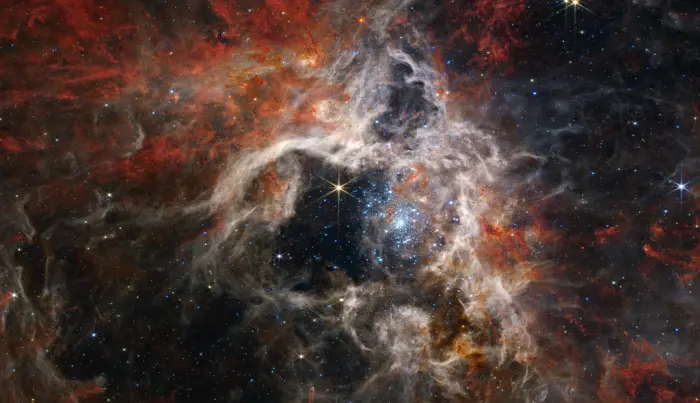
In this mosaic image stretching 340 light-years across, Webb’s Near-Infrared Camera (NIRCam) displays the Tarantula Nebula star-forming region in a new light, including tens of thousands of never-before-seen young stars that were previously shrouded in cosmic dust. The most active region appears to sparkle with massive young stars, appearing pale blue. Scattered among them are still-embedded stars, appearing red, yet to emerge from the dusty cocoon of the nebula. NIRCam is able to detect these dust-enshrouded stars thanks to its unprecedented resolution at near-infrared wavelengths. To the upper left of the cluster of young stars, and the top of the nebula’s cavity, an older star prominently displays NIRCam’s distinctive eight diffraction spikes, an artefact of the telescope’s structure. Following the top central spike of this star upward, it almost points to a distinctive bubble in the cloud. Young stars still surrounded by dusty material are blowing this bubble, beginning to carve out their own cavity. Astronomers used two of Webb’s spectrographs to take a closer look at this region and determine the chemical makeup of the star and its surrounding gas. This spectral information will tell astronomers about the age of the nebula and how many generations of star birth it has seen. Farther from the core region of hot young stars, cooler gas takes on a rust colour, telling astronomers that the nebula is rich with complex hydrocarbons. This dense gas is the material that will form future stars. As winds from the massive stars sweep away gas and dust, some of it will pile up and, with gravity’s help, form new stars. Image credit: NASA, ESA, CSA, and STScI (CC BY 4.0)
The Tarantula Nebula is the most active massive star-forming region in the Local Group of galaxies. If it were as close to the solar system as the more famous Orion Nebula, the Tarantula would be visible during the day and cast shadows.
The Orion Nebula, while better-known in the northern hemisphere, is only a hundredth the size of 30 Doradus. It is the nearest massive starburst region to the solar system, which is why it appears bright enough to be visible to the unaided eye.
The Tarantula Nebula lies in the far southern sky and is visible mainly from the southern latitudes. In the northern hemisphere, it is not very well-known because it never rises for observers in the mid-northern latitudes.
The Tarantula lies on the leading edge of the Large Magellanic Cloud, where ram pressure stripping and the compression of the interstellar medium trigger intense starburst activity. The interaction with the Milky Way and the proximity to the Small Magellanic Cloud (SMC) have contributed to the energetic star formation in the nebula.
The Large Magellanic Cloud (LMC) is a small satellite galaxy of the Milky Way and one of the nearest galaxies to our own. The dwarf galaxy is located on the border between the constellations Dorado and Mensa. It contains a number of star-forming regions, but none of them quite so bright and large as the Tarantula. Our own Milky Way galaxy does not host any known star-forming region that is as large and as active as 30 Doradus.
30 Doradus was named the Tarantula because of its appearance in long exposure photographs in the mid-20th century. The deep exposures of the nebula revealed the spidery tendrils formed by the nebula’s gas, lit by the intense ultraviolet light of young stars embedded in the nebula. The nebula is a giant starburst region where the energy from the bright, hot young stars creates huge voids and filaments in the surrounding clouds of gas. In images, its glowing filaments of dust resemble the legs of a spider.
The designation 30 Doradus was often taken to refer to a star or to the central open star cluster of the Tarantula, NGC 2070. Now it is commonly used to refer to the whole nebula.
Stars
30 Doradus contains around 820,000 stars. More than a half of them are members of the nebula’s central cluster, NGC 2070. The stars vary dramatically in mass, from record-holders with a mass of almost 200 solar masses to smaller stars with only 50% of the Sun’s mass.
The central region of the Tarantula Nebula contains thousands of massive stars that are blasting away material and generating intense radiation and strong stellar winds. These winds and the supernova events in the region heat up the gas to millions of degrees.
The central star cluster of the Tarantula Nebula is NGC 2070 (Caldwell 103), a candidate super star cluster that generates the most energy responsible for making the surrounding nebula glow. NGC 2070 contains a central condensation, catalogued as R136, which is home to some of the most massive and most luminous stars known.
Most of the Tarantula’s record-breaking stars lie in or near the central R136 cluster. BAT99-98, a Wolf-Rayet star near R136, has a mass of 226 solar masses and a luminosity of 5 million Suns. It is often referred to as the most massive star known.
R136a1, a Wolf-Rayet star in the cluster, has 196 times the Sun’s mass and 4,677,000 times its luminosity.
The blue supergiant Melnick 42, located near the cluster, has a mass 189 times that of the Sun and a luminosity 3.6 million times the Sun’s. It spins at 240 km/s.
Melnick 34 is a binary system – the most massive one known – composed of two WR stars that are among the most massive and most luminous stars known, with masses 148 and 135 times that of the Sun. The star system lies near R136.
Other massive stars in the Tarantula include the Wolf-Rayet stars R136a2 (151 M☉, 3,548,000 L☉), R136a3 (155 M☉, 3,631,000 L☉), R136c (142 M☉, 3,800,000 L☉), and the runaway star VFTS 682 (137.8 M☉, 3,200,000 L☉).
Most of these stars are only about 1 million years old.
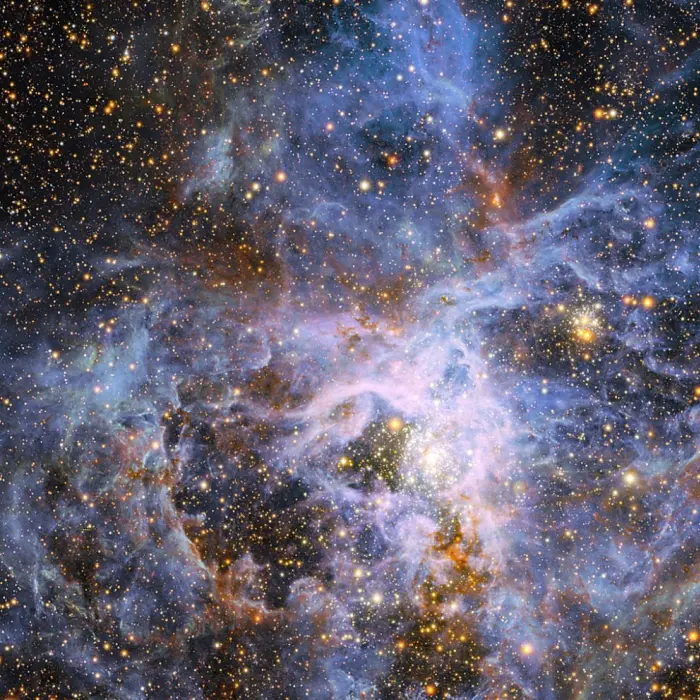
Tarantula Nebula – At the exact centre lies the brilliant but isolated star VFTS 682 and to its lower right the very rich star cluster R 136. The origins of VFTS are unclear — was it ejected from R 136 or did it form on its own? The star appears yellow-red in this view, which includes both visible-light and infrared images from the Wide Field Imager at the 2.2-metre MPG/ESO telescope at La Silla and the 4.1-metre infrared VISTA telescope at Paranal, because of the effects of dust. Image: ESO/M.-R. Cioni/VISTA Magellanic Cloud survey. Acknowledgment: Cambridge Astronomical Survey Unit (CC BY 4.0)
NGC 2070
The open cluster NGC 2070 is one of the most energetic clusters discovered to date. It lies at the heart of the Tarantula Nebula and contains about 500,000 stars. The hot, luminous cluster members produce most of the energy that makes the dust and gas of the surrounding nebula visible.
NGC 2070 has an apparent magnitude of 7.25 and lies 157,000 light-years away. With an apparent size of 3.50 by 3.50 arcminutes, it can be observed in small and medium telescopes. It is listed as Caldwell 103 in the Caldwell catalogue of objects visible in amateur telescopes.
Some of the cluster’s stars have already ended their lives as supernovae. Astronomers have detected an O-type main sequence star, VFTS 243, that orbits a stellar mass black hole. These black holes form when exceptionally massive stars go out as supernovae. The primary component has a mass of 25 solar masses, while the remnant of its companion has a mass of about 9 solar masses. The two components have an orbital period of 10.4 days.
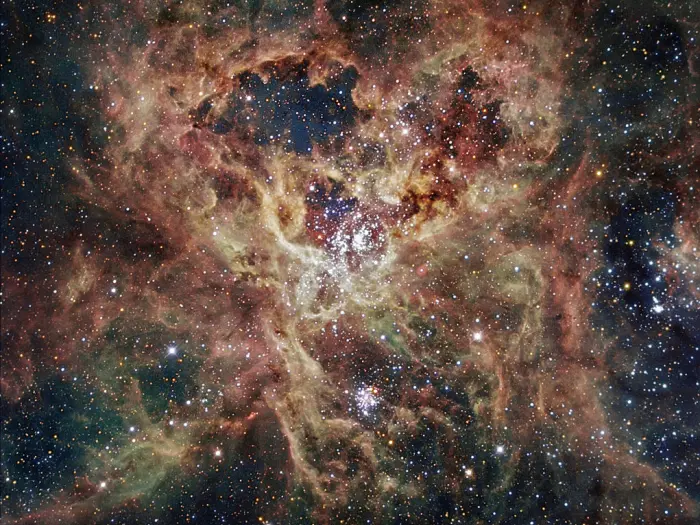
NGC 2070, image credit: ESO (CC BY 4.0)
R136
R136 is a massive concentration of young stars at the centre of the larger NGC 2070. The young star cluster hosts some of the most massive stars known, including the Wolf-Rayet stars R136a1 (196 M☉), R136a2 (151 M☉), and R136a3 (155 M☉). Most of its brighter members are Wolf-Rayet stars and O-type giants and supergiants. These stars have surface temperatures of 45,000 – 55,000 K and luminosities of 1.5 – 4.7 million times that of the Sun.
When it was first catalogued, the R136 cluster was an unresolved stellar object, listed as HD 38268 and Brey 82 (a Wolf-Rayet star). Until the 1980s, R136 was suspected to contain a single behemoth star that defied the laws of physics with a mass of about 1,000 Suns. As astronomers developed high-resolution imaging techniques, they were able to resolve more and more individual members.
Today, the cluster is known to contain 72 exceptionally massive and luminous O-type stars and Wolf-Rayet stars. These stars lie within 20 arcseconds (16.3 light-years or 5 parsecs) of the cluster’s centre. Several dozen of the cluster members have masses more than 100 times that of the Sun. The most massive of these stars started their main sequence life with 200 – 300 solar masses, but have lost a sizable portion of their initial mass through strong stellar winds.
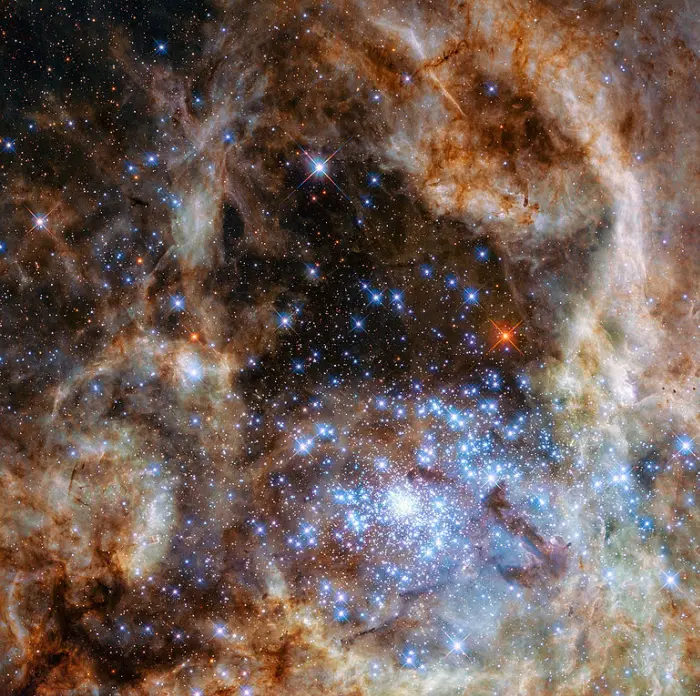
A Hubble Space Telescope image of the R136 super star cluster, near the center of the 30 Doradus Nebula, also known as the Tarantula Nebula or NGC 2070. Image credit: NASA, ESA, F. Paresce (INAF-IASF, Bologna, Italy), R. O’Connell (University of Virginia, Charlottesville), and the Wide Field Camera 3 Science Oversight Committee
R136 has an estimated mass of 450,000 solar masses and is expected to become a globular cluster in the future. It holds almost 90,000 solar masses of material within about 65 light-years, which is comparable to the average size of globular clusters in our galaxy.
R136 generates almost 30% of the energy that excites the whole Tarantula Nebula and makes it glow. The central concentration is only 6.5 light-years (2 parsecs) across.
The cluster is exceptionally dense. It has about 200 times the stellar density of that found in an OB association. The estimated age of the cluster is less than 2 million years. The stars of R136 have not yet had enough time to evolve to the point where they go out as supernovae. The cluster has a small number of B-type stars, but it does not contain any red supergiants, blue supergiants, or luminous blue variables (LBVs).
The brightest members of R136 are WNh stars (population I Wolf-Rayet stars with hydrogen lines in their spectra), blue O-type supergiants, and slash stars. All these stars are exceptionally massive and luminous.
Some of the cluster’s original members have been ejected from their birthplace. One of these, VFTS 106, is a massive star that now lies northwest of the cluster NGC 2060. It was expelled from R136 about 1.5 million years ago and is moving through space at 360,000 km/h (225,000 mph).
The cluster is also referred to as RMC 136. The designation comes from the Radcliffe Observatory Magellanic Clouds catalogue.
NGC 2060
NGC 2060 is a loose open cluster that appears very close to NGC 2070. It has an apparent magnitude of 9.59 and lies about 290 light-years southwest of R136.
The cluster is associated with the supernova remnant N157B (30 Doradus B), a faint nebula in which strong radio emission has been detected. The supernova occurred around 5,000 years ago.
A pulsar (PSR J0537-6910), the remnant of the progenitor star, was discovered in 1998. The rapidly spinning neutron star has about the same age as the supernova remnant. It spins on its axis every 16 milliseconds.
NGC 2060 also contains the runaway star VFTS 102, believed to be a companion of the pulsar. The hot blue O-type main sequence star was likely ejected from the star system when the more evolved star went out as a supernova.
VFTS 102 is the star with the second fastest rotation rate known. It spins at about 610 km/s. Astronomers believe that its fast spins rate is caused by the transfer of material from the binary companion that met its end as a supernova. The star may have also been expelled from the core of R136. It has a mass about 25 times that of the Sun and a luminosity of 100,000 Suns. It has an oblate shape due to its fast spin rate.
NGC 2060 was discovered by John Herschel in 1836. It has an estimated age of 10 million years.
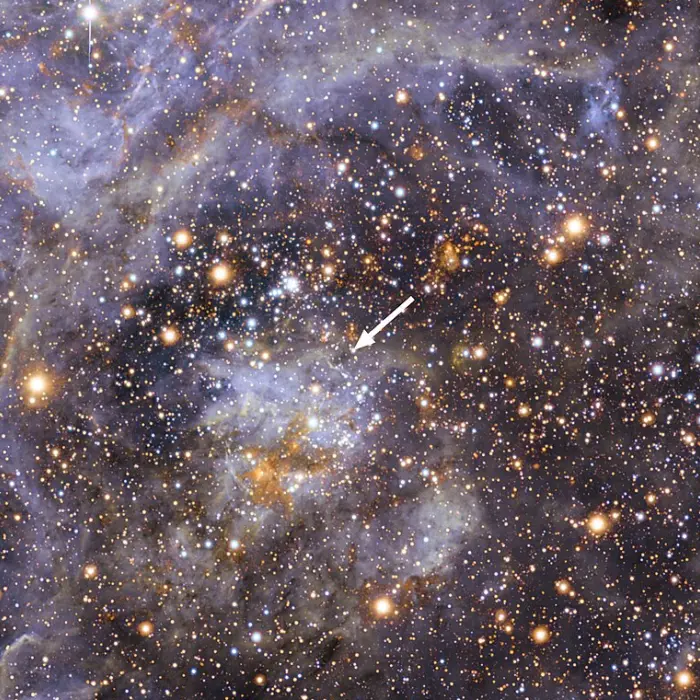
This view shows part of the stellar nursery called the Tarantula Nebula in the Large Magellanic Cloud, a small neighbour of the Milky Way. At the centre lies the brilliant star VFTS 102 This view includes both visible-light and infrared images from the Wide Field Imager at the MPG/ESO 2.2-metre telescope at La Silla and the 4.1-metre infrared VISTA telescope at Paranal. Image credit: ESO/M.-R. Cioni/VISTA Magellanic Cloud survey. Acknowledgment: Cambridge Astronomical Survey Unit (CC BY 3.0)
Hodge 301
Hodge 301 is one of the major clusters in the Tarantula Nebula. It is older and more evolved than R136. It lies 168,000 light-years away and shines at magnitude 11. The cluster formed when the nebula was much younger, in the first wave of star formation in the region.
Hodge 301 lies about 145 light-years northwest of R136. With an estimated age of 20 – 25 million years, it is about 10 times older than R136. At least 40 of its stars have already gone out as supernovae, resulting in dramatic gas motions and X-ray emission in the area. As the nebula’s filaments are compressed by the supernova events, they become sites where new generations of stars will eventually be born.
The stars of Hodge 301 have had enough time to clear the surrounding gas and dust. Unlike the nebula’s younger clusters, they are easily visible in the optical band.
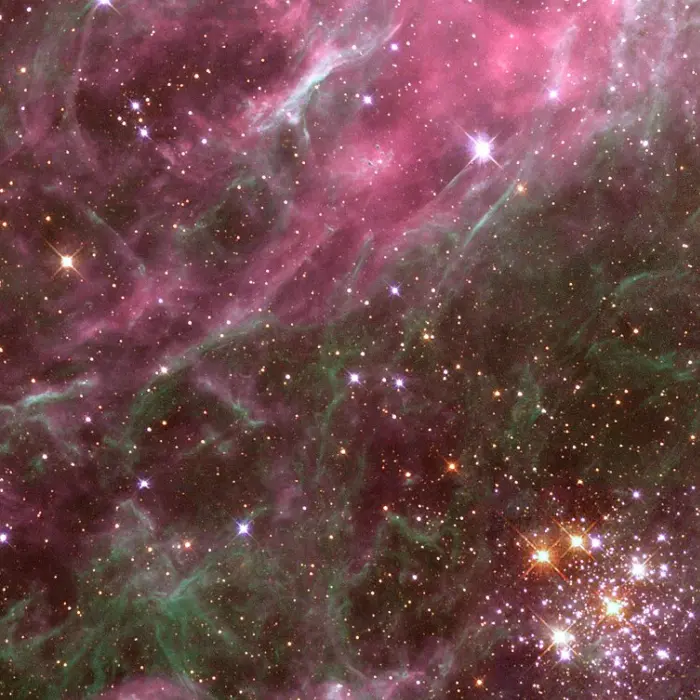
Part of the Tarantula Nebula, a giant HII region in the Large Magellanic Cloud. The star cluster at the lower right is Hodge 301. Image credit: The Hubble Heritage Team (AURA / STScI / NASA) (PD)
SN 1987A
SN 1987A is a supernova remnant located in the outer regions of the Tarantula Nebula. The supernova event was discovered on February 24, 1987. It had begun to rapidly brighten early on February 23 and peaked at apparent magnitude 2.9.
SN 1987A is the remnant of a B-type supergiant, Sanduleak −69 202 (Sk -69 202), that went out as a type II supernova after its core collapsed. The discovery was unexpected because, at the time, models of high mass star evolution did not predict that blue supergiants could trigger supernova events.
At a distance of 168,000 light-years, SN 1987A was the nearest observed supernova since Kepler’s Supernova (SN 1604), which occurred less than 20,000 light-years away. Even though the remnant has been observed regularly by the Hubble Space Telescope since 1990, a neutron star left in the wake of the supernova has not been detected. At least not directly.
In 2021, astronomers found evidence for its existence based on the data collected with NASA’s Chandra X-ray Observatory, NASA’s Nuclear Spectroscopic Telescope Array (NuSTAR), and the Atacama Large Millimeter Array (ALMA) in the Atacama Desert of northern Chile.
A team led by Emanuele Greco of the University of Palermo in Italy discovered low-energy X-rays crashing into the surrounding material, as well as evidence of high-energy particles, indicating either a pulsar wind nebula or blast wave acceleration of the particles.
X-ray observations support the pulsar wind nebula scenario, which requires the presence of a neutron star. If the pulsar is present, it is the youngest one ever found and will provide astronomers with a unique opportunity to study how these neutron stars evolve over time.
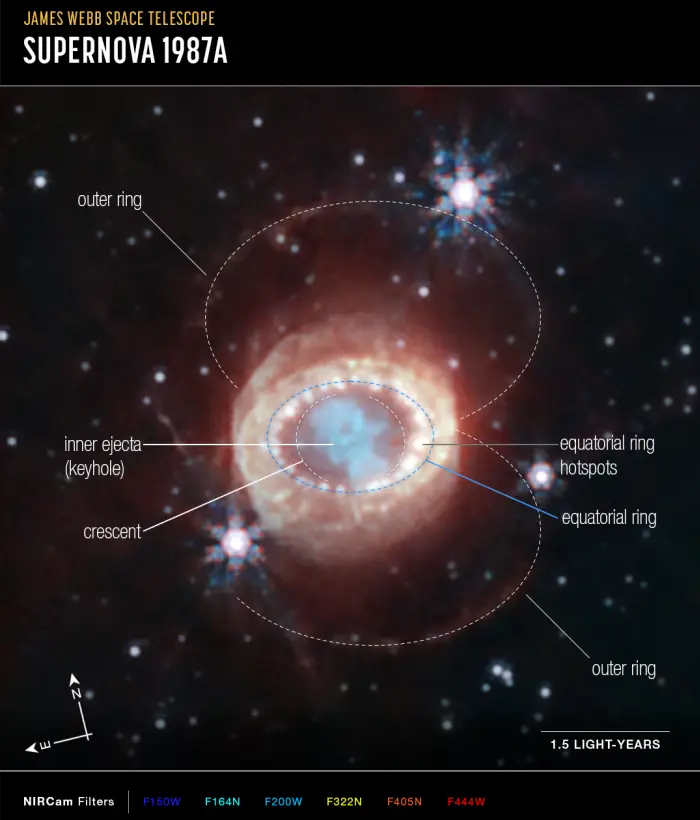
Webb’s NIRCam (Near-Infrared Camera) captured this detailed image of SN 1987A (Supernova 1987A), which has been annotated to highlight key structures. At the center, material ejected from the supernova forms a keyhole shape. Just to its left and right are faint crescents newly discovered by Webb. Beyond them an equatorial ring, formed from material ejected tens of thousands of years before the supernova event, contains bright hot spots. Exterior to that is diffuse emission and two faint outer rings. In this image blue represents light at 1.5 microns (F150W), cyan 1.64 and 2.0 microns (F164N, F200W), yellow 3.23 microns (F323N), orange 4.05 microns (F405N), and red 4.44 microns (F444W). Image credit: NASA, ESA, CSA, Mikako Matsuura (Cardiff University), Richard Arendt (NASA-GSFC, UMBC), Claes Fransson (Stockholm University), Josefin Larsson (KTH); Image processing: Alyssa Pagan (STScI)
Facts
The Tarantula Nebula was originally thought to be a star. In 1751, the French astronomer Nicolas Louis de Lacaille was the first to recognize its nebular nature.
Lacaille observed the nebula during his stay at the Cape of Good Hope from 1751 to 1753. He catalogued the object as the second of the “Nebulae of the First Class” and “Nebulosities not accompanied by any star visible in the telescope of two feet.”
German astronomer Johann Elert Bode catalogued the nebula as number 30 in the constellation “Xiphias or Dorado” in his Allgemeine Beschreibung und Nachweisung der Gestirne catalogue, which accompanied his star atlas Uranographia of 1801. Bode noted that 30 Doradus was a nebulous object and did not give it a stellar magnitude.
The size and luminosity make the Tarantula a popular target for astronomers looking to study star formation and evolution. Over the decades, the stellar nursery has been imaged by the Hubble Space Telescope (HST), the Spitzer Space Telescope, the Very Large Telescope (VLT), the Chandra X-ray Observatory, and most recently by the James Webb Space Telescope (JWST).
The images obtained with these and other instruments have revealed many star clusters of different ages, providing scientists with insights into the different stages of star formation, evolution, and fiery ends of massive stars in the nebula. The open clusters in the Tarantula Nebula have ages between 2 and 25 million years and are the perfect laboratory for studying the evolution of young stellar objects.
The Tarantula Nebula has a similar chemical composition to what most nebulae in the Milky Way had several billion years ago, when stars were forming at a much faster rate. It astronomers to study the conditions in the Milky Way when the galaxy was much younger.
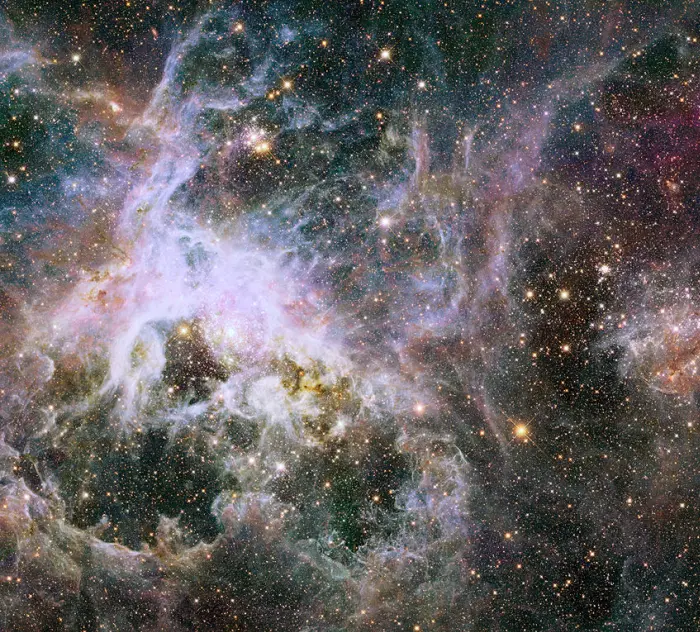
This Hubble image shows a cosmic creepy-crawly known as the Tarantula Nebula in infrared light. This region is full of star clusters, glowing gas, and thick dark dust. Created using observations taken as part of the Hubble Tarantula Treasury Project (HTTP), this image was snapped using Hubble’s Wide Field Camera 3 (WFC3) and Advanced Camera for Surveys (ACS). The Hubble Tarantula Treasury Project (HTTP) is scanning and imaging many of the many millions of stars within the Tarantula, mapping out the locations and properties of the nebula’s stellar inhabitants. These observations will help astronomers to piece together an understanding of the nebula’s skeleton, viewing its starry structure. Image credit: NASA, ESA, E. Sabbi (STScI)
James Webb Space Telescope images
The Tarantula Nebula was captured by NASA and ESA’s James Webb Space Telescope (JWST) in 2023. Webb’s infrared view revealed thousands of previously undetected young stars and provided astronomers with a more detailed view of the nebula’s composition and structure. The space telescope also caught a number of distant galaxies that appear in the background of the Tarantula and the LMC.
Webb’s Near-Infrared Camera (NIRCam) showed a cavity hollowed out by the intense radiation from a young cluster of massive stars, surrounded by the dense regions of dust and gas that are still resisting the young stars’ ultraviolet light. The UV radiation and strong stellar winds form pillar-like structures that harbour protostars, young stellar objects still embedded in their birth clouds.
The Near-Infrared Spectrograph (NIRSpec) captured a young star beginning to emerge from its dusty cocoon and carving out a bubble around itself, while the Mid-Infrared Instrument (MIRI) showed the cooler dust and gas in the nebula, dotted with protostars.
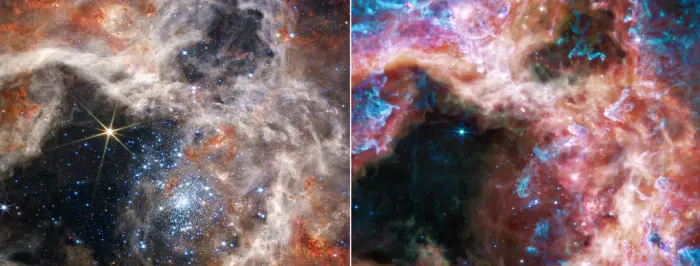
Take a moment to stare into thousands of never-before-seen young stars in the Tarantula Nebula. The James Webb Space Telescope reveals details of the structure and composition of the nebula, as well as dozens of background galaxies. This image is a side-by-side of the near-infrared view captured by NIRCam (left) and the mid-infrared view captured by MIRI. Image credit: NASA, ESA, CSA, STScI, Webb ERO Production Team (CC BY 2.0)
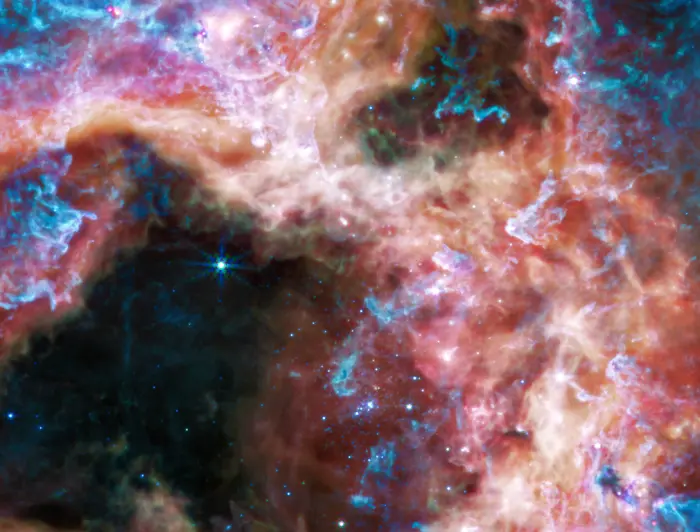
Stellar nursery 30 Doradus gets its nickname of the Tarantula Nebula from its long, dusty filaments. Located in the Large Magellanic Cloud galaxy, it’s the largest and brightest star-forming region near our own galaxy, plus home to the hottest, most massive stars known. At the longer wavelengths of light captured by its Mid-Infrared Instrument (MIRI), Webb focuses on the area surrounding the central star cluster and unveils a very different view of the Tarantula Nebula. In this light, the young hot stars of the cluster fade in brilliance, and glowing gas and dust come forward. Abundant hydrocarbons light up the surfaces of the dust clouds, shown in blue and purple. Image credit: NASA, ESA, CSA, STScI, Webb ERO Production Team (CC BY 2.0)
Location
The Tarantula Nebula lies in the faint southern constellation Dorado (the Dolphinfish). It marks the southeastern corner of the Large Magellanic Cloud when seen from Earth. It appears just north of the smaller H II region known as the Ghost Head Nebula (NGC 2080).
The LMC is visible to the unaided eye on a clear, dark night. The Milky Way’s satellite can be found by following the imaginary line extended from Sirius, the brightest star in the sky, through Canopus, the second brightest star.
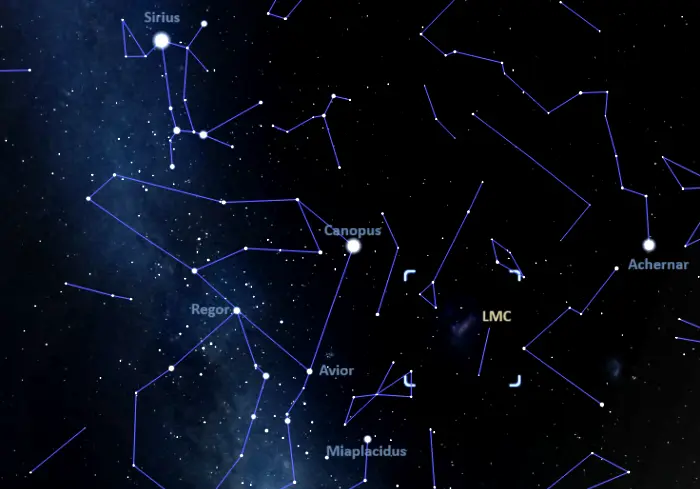
The location of the Large Magellanic Cloud (LMC), image: Stellarium
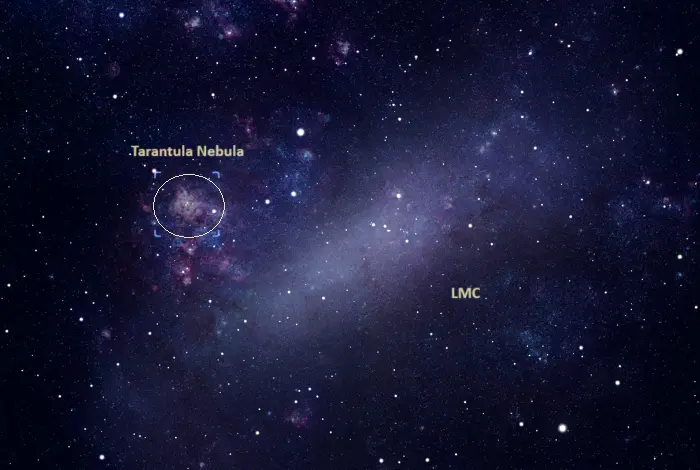
The location of the Tarantula Nebula (NGC 2070) in the Large Magellanic Cloud (LMC), image: Stellarium
At declination -69°, the Tarantula Nebula is visible from locations south of the latitude 21° N. It never rises very high above the horizon for northern observers in tropical latitudes. However, observers in the southern hemisphere can see the nebula and the Large Magellanic Cloud almost year-round, depending on the location.
The Tarantula Nebula can be observed in small telescopes. In 4-inch telescopes, the R136 cluster is visible as a region 1 arcminute across, and some of the nebula’s gaseous filaments may be seen in good conditions. Larger instruments will reveal more details of the nebula’s structure.
The best time of the year to observe the Tarantula Nebula, the Large Magellanic Cloud and other deep sky objects in Dorado is during the month of January, when the Dolphinfish appears higher above the horizon in the early evening.
Tarantula Nebula – 30 Doradus
| Constellation | Dorado |
| Object type | H II region |
| Right ascension | 05h 38m 36.0s |
| Declination | −69° 05′ 11′′ |
| Apparent magnitude | +8 |
| Apparent size | 40′ × 25′ |
| Radius | 931 light-years |
| Distance | 160 ± 10 kilolight-years (49 ± 3 kiloparsecs) |
| Names and designations | Tarantula Nebula, Doradus Nebula, 30 Doradus, NGC 2070, LHA 120-N 157A |
Images
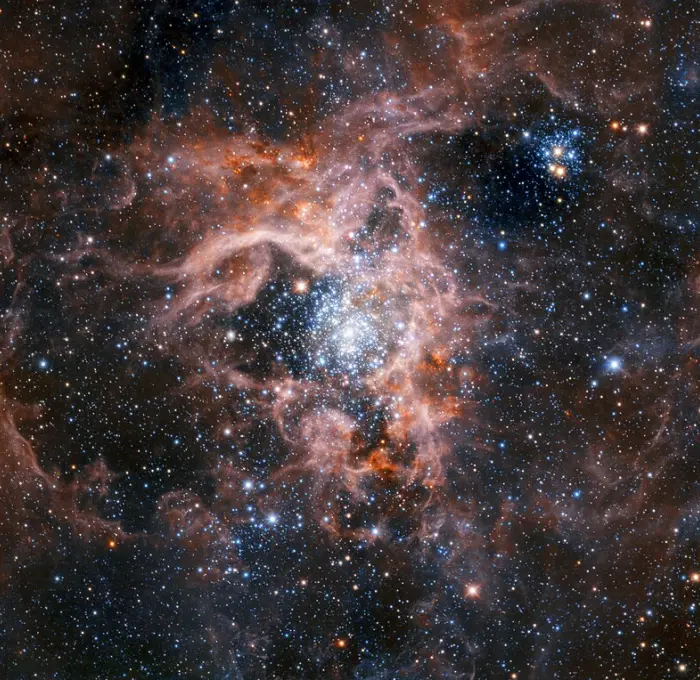
This image of the dramatic star formation region 30 Doradus, also known as the Tarantula Nebula, was created from a mosaic of images taken using the HAWK-I instrument working with the Adaptive optics Facility of ESO’s Very Large Telescope in Chile. The stars are significantly sharper than the same image without adaptive optics being used, and fainter stars can be seen. Image credit: ESO (CC BY 4.0)
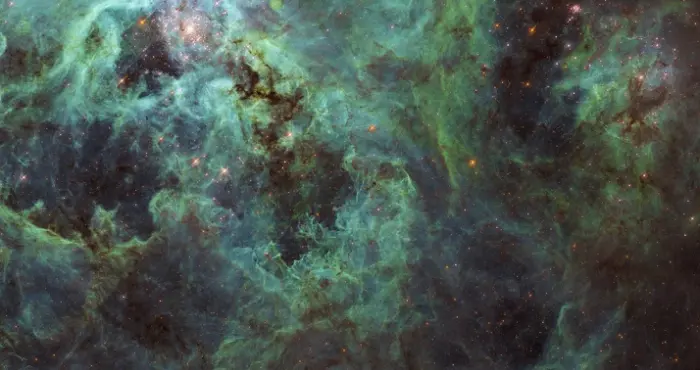
The Tarantula Nebula is more than a thousand light-years in diameter, a giant star forming region within nearby satellite galaxy the Large Magellanic Cloud, about 180 thousand light-years away. Within the Tarantula, intense radiation, stellar winds and supernova shocks from the central young cluster of massive stars, cataloged as R136, energize the nebular glow and shape the spidery filaments. Dark dust lanes obscure some of the ionized gas lending spectacular depth to the space. Image credit: NASA & ESA (the Hubble Space Telescope); processing: William Ostling (CC BY 2.0)
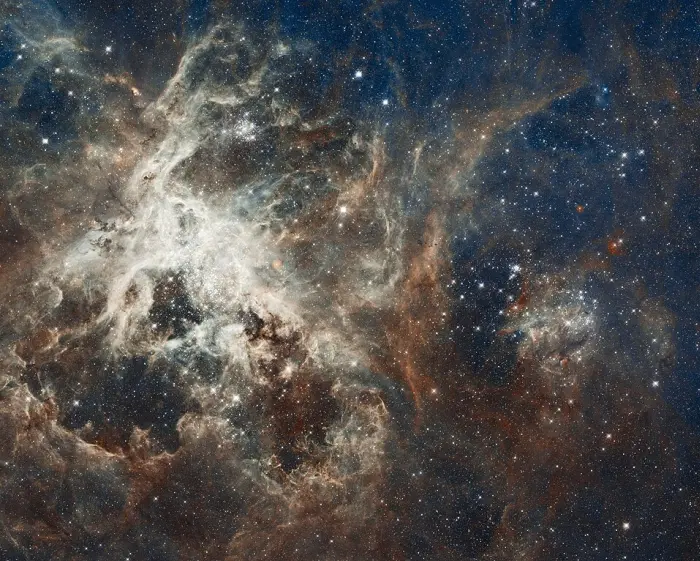
The composite image of 30 Doradus comprises one of the largest mosaics ever assembled from Hubble photos and includes observations taken by Hubble’s Wide Field Camera 3 and Advanced Camera for Surveys. The Hubble image is combined with ground-based data of the Tarantula Nebula, taken with the European Southern Observatory’s 2.2-meter telescope in La Silla, Chile. NASA and the Space Telescope Science Institute are releasing the image to celebrate Hubble’s 22nd anniversary. Collectively, the stars in this image are millions of times more massive than our Sun. The image is roughly 650 light-years across and contains some rambunctious stars, from one of the fastest rotating stars to the speediest and most massive runaway star. Image credit: NASA, ESA, ESO, D. Lennon and E. Sabbi (ESA/STScI), J. Anderson, S. E. de Mink, R. van der Marel, T. Sohn, and N. Walborn (STScI), N. Bastian (Excellence Cluster, Munich), L. Bedin (INAF, Padua), E. Bressert (ESO), P. Crowther (Sheffield), A. de Koter (Amsterdam), C. Evans (UKATC/STFC, Edinburgh), A. Herrero (IAC, Tenerife), N. Langer (AifA, Bonn), I. Platais (JHU) and H. Sana (Amsterdam)
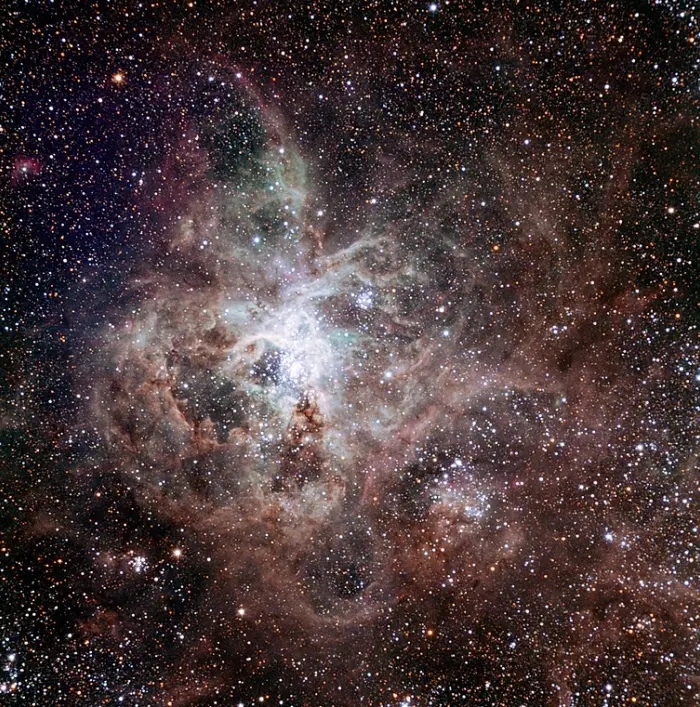
This first light image of the TRAPPIST national telescope at La Silla shows the Tarantula Nebula, located in the Large Magellanic Cloud (LMC) — one of the galaxies closest to us. Also known as 30 Doradus or NGC 2070, the nebula owes its name to the arrangement of bright patches that somewhat resembles the legs of a tarantula. Taking the name of one of the biggest spiders on Earth is very fitting in view of the gigantic proportions of this celestial nebula — it measures nearly 1000 light-years across! Its proximity, the favourable inclination of the LMC, and the absence of intervening dust make this nebula one of the best laboratories to help understand the formation of massive stars better. The image was made from data obtained through three filters (B, V and R) and the field of view is about 20 arcminutes across. Image credit: TRAPPIST/E. Jehin/ESO (CC BY 4.0)
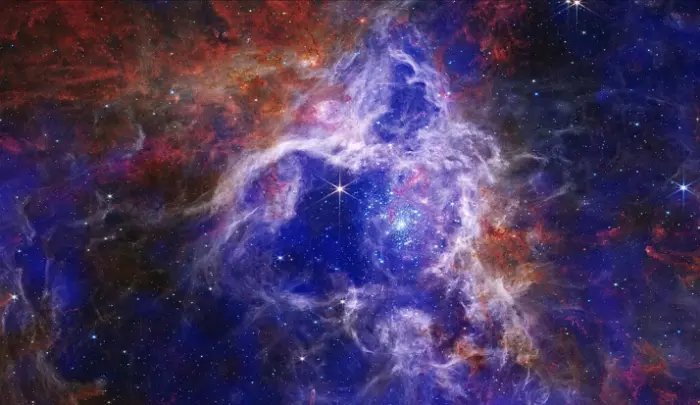
Chandra X-ray Observatory teamed up with the Webb telescope to create a new stunning composite image of the Tarantula Nebula. Chandra’s X-rays (shown in royal blue and purple) identify extremely hot gas and supernova remnants, while Webb reveals forming baby stars. Image credit: X-ray: NASA/CXC/Penn State Univ./L. Townsley et al.; IR: NASA/ESA/CSA/STScI/JWST ERO Production Team (CC BY 2.0)
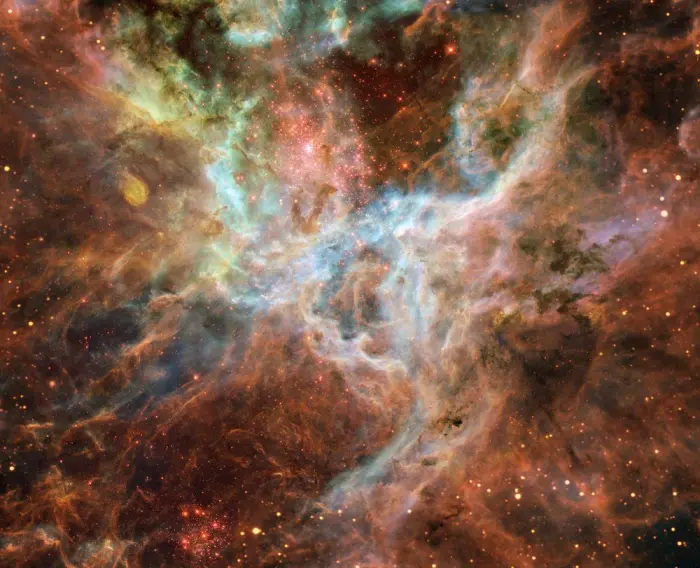
Central portion of the Tarantula Nebula. “This mosaic of the Tarantula Nebula consists of images from the NASA/ESA Hubble Space Telescope’s Wide Field and Planetary Camera 2 (WFPC2) and was created by 23 year old amateur astronomer Danny LaCrue. … Additional image processing was done by the Hubble European Space Agency Information Centre.” Image: ESA/NASA, ESO and Danny LaCrue
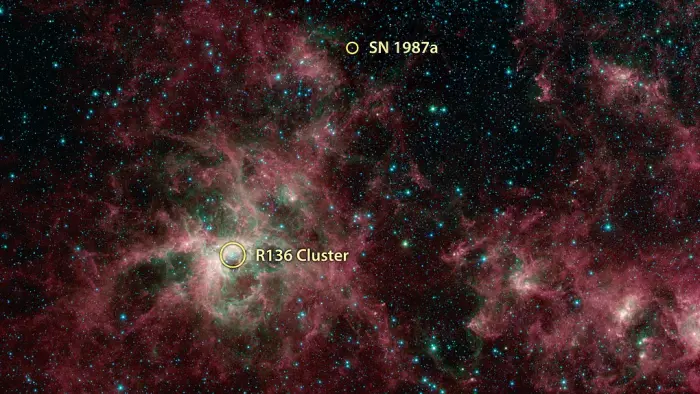
This image from NASA’s Spitzer Space Telescope shows the Tarantula Nebula in three wavelengths of infrared light, each represented by a different color. The magenta-colored regions are dust composed of molecules called polycyclic aromatic hydrocarbons (PAHs), which are also found in ash from coal, wood and oil fires on Earth. PAHs emit in multiple wavelengths. The PAHs emit in multiple wavelengths, so the magenta color is a combination of red (corresponding to an infrared wavelength of 8 micrometers) and blue (3.6 micrometers). The green color in this image shows the presence of particularly hot gas emitting infrared light at a wavelength of 4.5 micrometers. The stars in the image are mostly a combination of green and blue. White hues indicate regions that radiate in all three wavelengths. Image credit: NASA/JPL-Caltech (PD)
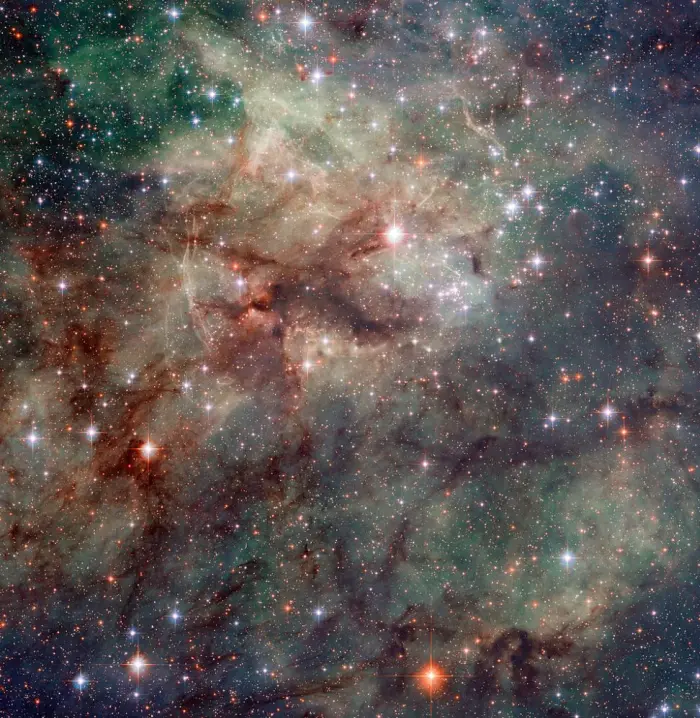
Hubble has taken this stunning close-up image of part of the Tarantula Nebula, the most luminous nebula of its type in the local Universe. Image: NASA, ESA
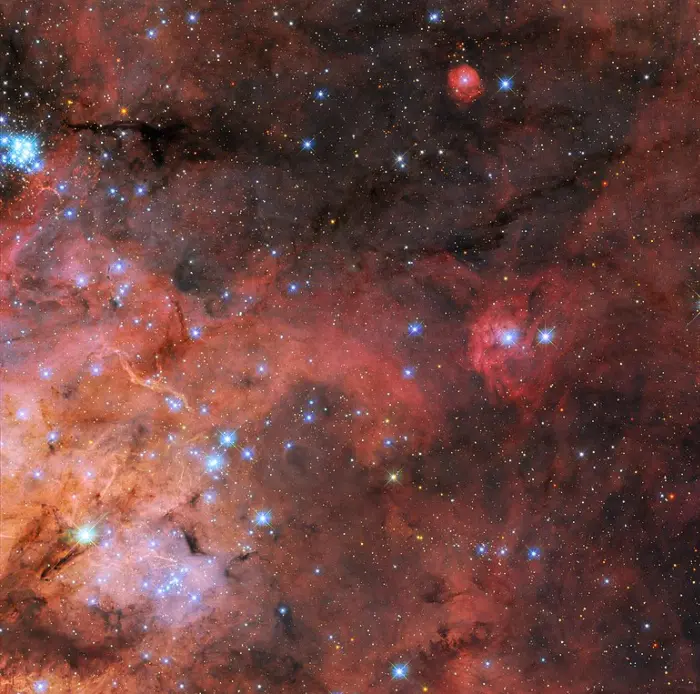
Tarantula Nebula by the NASA/ESA Hubble Space Telescope. Image credit: ESA/Hubble & NASA, C. Murray, E. Sabbi; Acknowledgement: Y.-H. Chu (CC BY 4.0)
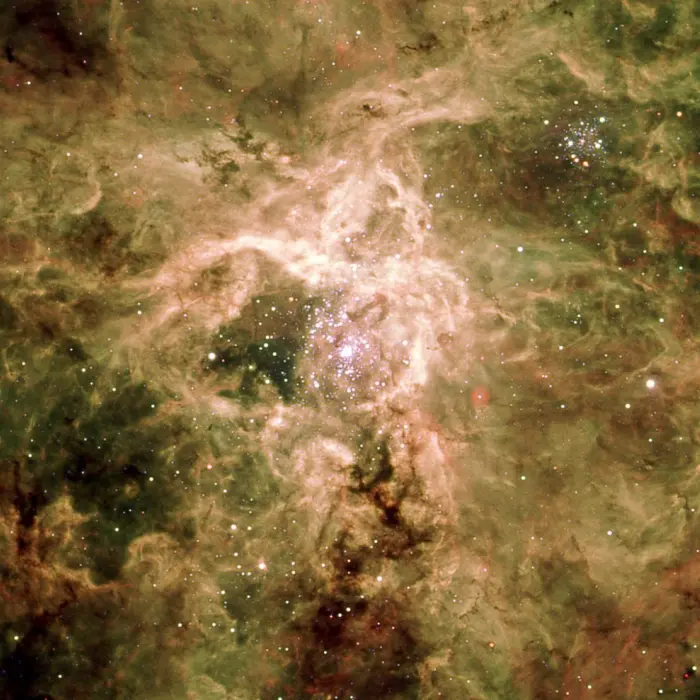
Three-color image of the Tarantula Nebula in the Large Magellanic Cloud. The image is based on observations made on 10 February 2002 and 22 March 2003 with the FORS1 multi-mode instrument on ESO’s Very Large Telescope in three different narrow-band filters (centred on 485 nm, 503 nm, and 657 nm), for a total exposure time slightly above 3 minutes only. The data were extracted from the ESO Science Archive and processed by Henri Boffin (ESO). In the centre is star cluster R136, which in turn contains the compact cluster R136a as an unresolved blob here. Image: ESO (CC BY 2.0)

Using a combination of instruments on ESO’s Very Large Telescope, astronomers have discovered the most massive stars to date, some weighing at birth more than 300 times the mass of the Sun, or twice as much as the currently accepted limit of 150 solar masses. The most exceptional of these stars was found in the cluster RMC 136a (or R136 as it is more usually named). Named R136a1, it is found to have a current mass of 265 times that of the Sun. Being a little over a million years old, R136a1 is already “middle-aged” and has undergone an intense weight-loss programme, shedding a fifth of its initial mass over that time, or more than fifty solar masses. It also has the highest luminosity, close to 10 million times greater than the Sun. Image: ESO/P. Crowther/C.J. Evans (CC BY 4.0)
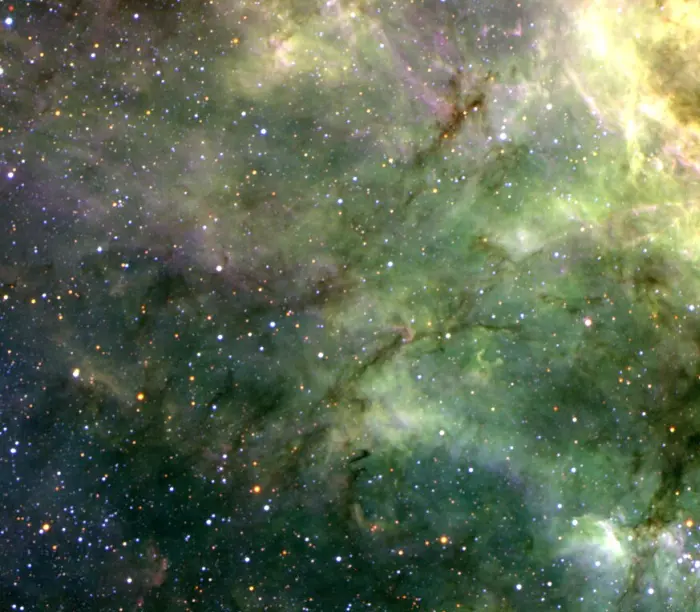
Filaments of ionized gas in the proximity of the R136 cluster, which lies beyond the lower left edge of the photo. The different hues are due to different physical conditions that manifest themselves in the spectrum of the light emitted by the gas. Note also the dark lanes running roughly from bottom left to upper right, which are due to filaments of obscuring dust seen in projection against the background of bright nebulosity. Image credit: ESO (CC BY 3.0)
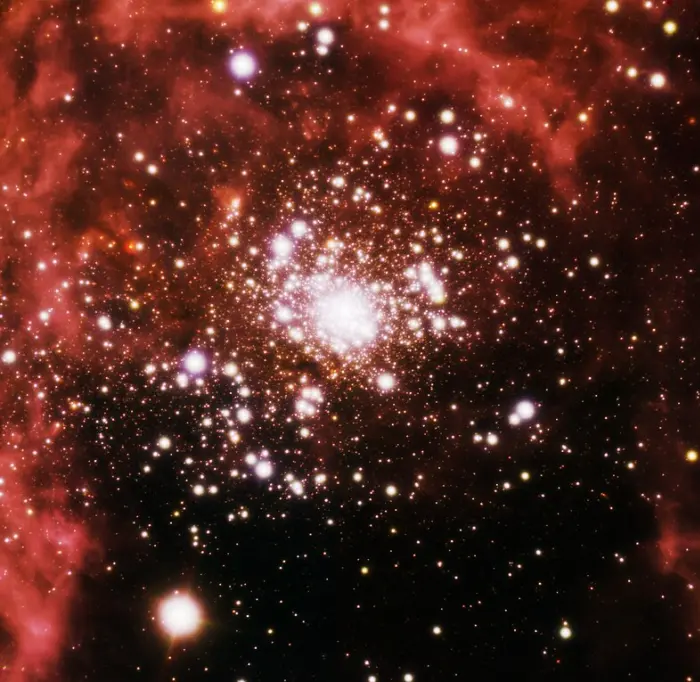
This near-infrared image obtained with GeMS adaptive optics system resolves the stars inside RMC 136, a giant star cluster within the Tarantula Nebula in the Large Magellanic Cloud. Credit: International Gemini Observatory, Robert Blum (National Optical Astronomy Observatory) and T.A. Rector (University of Alaska Anchorage) (CC BY 4.0)
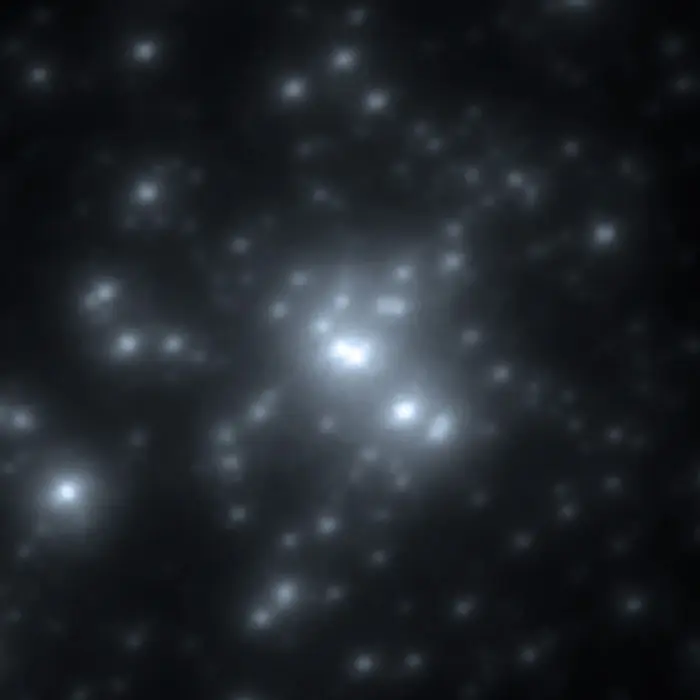
A near-infrared image of the R136 cluster, obtained at high resolution with the MAD adaptive optics instrument at ESO’s Very Large Telescope, provides unique details of its stellar content. At birth, the three brightest stars each weighed more than 150 times the mass of the Sun. The most massive star, known as R136a1 and located at the centre of the image, has been found to have a current mass of 265 times that of the Sun. It also has the highest luminosity, close to ten million times greater than the Sun. Image: ESO/P. Crowther/C.J. Evans (CC BY 4.0)
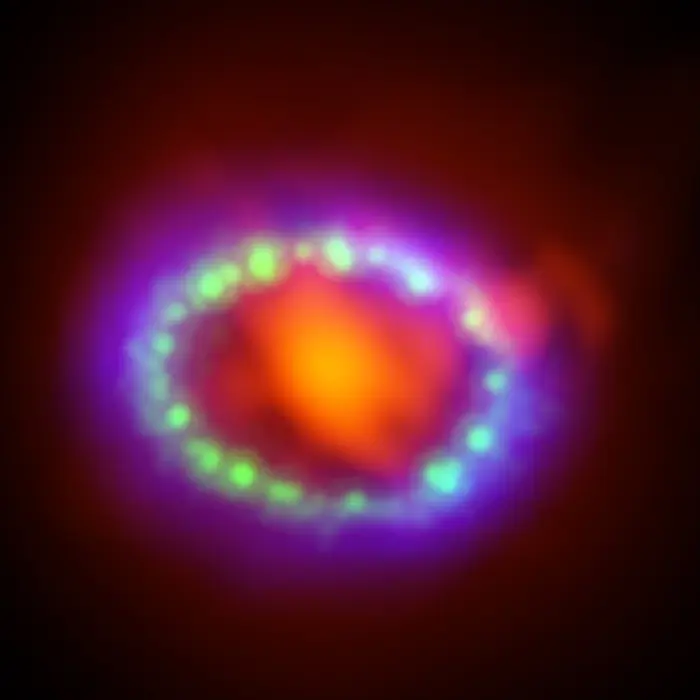
This image shows the remnant of Supernova 1987A seen in light of very different wavelengths. ALMA data (in red) shows newly formed dust in the centre of the remnant. Hubble (in green) and Chandra (in blue) data show the expanding shock wave. Image credit: ALMA (ESO/NAOJ/NRAO)/A. Angelich. Visible light image: the NASA/ESA Hubble Space Telescope. X-Ray image: The NASA Chandra X-Ray Observatory (CC BY 4.0)
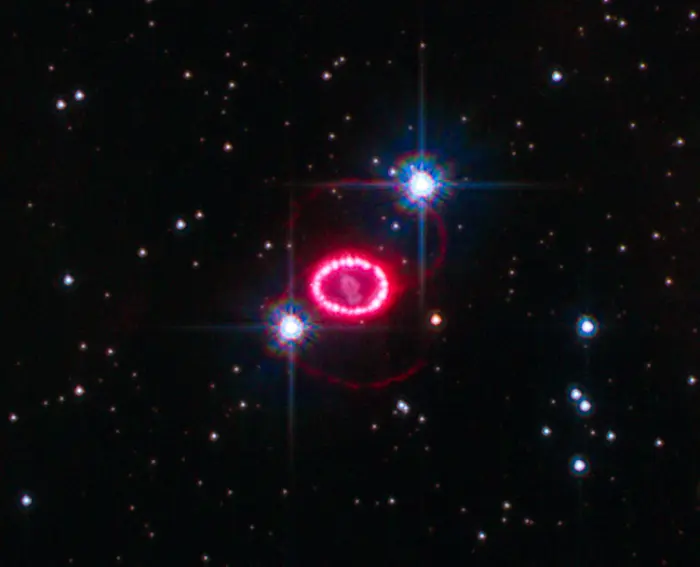
This image shows the entire region around supernova 1987A. The most prominent feature in the image is a ring with dozens of bright spots. A shock wave of material unleashed by the stellar blast is slamming into regions along the ring’s inner regions, heating them up, and causing them to glow. The ring, about a light-year across, was probably shed by the star about 20,000 years before it met its end. Image credit: NASA, ESA, K. France (University of Colorado, Boulder), and P. Challis and R. Kirshner (Harvard-Smithsonian Center for Astrophysics) (CC BY 2.0)
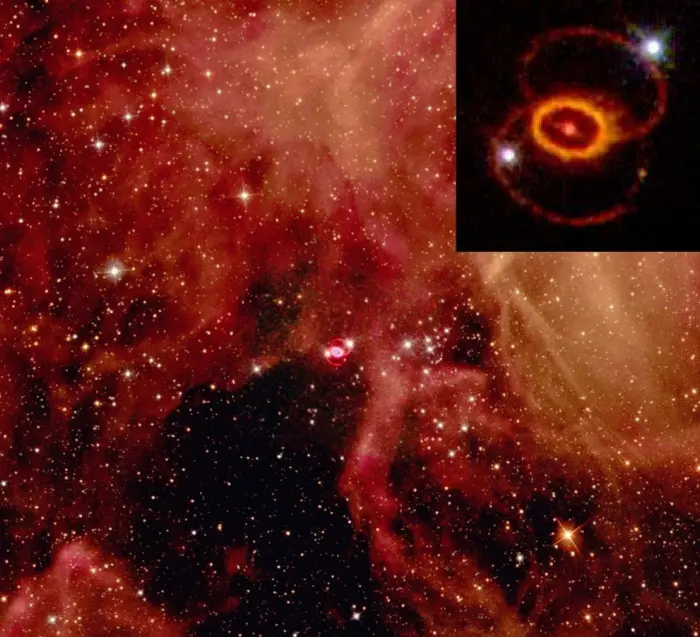
1987A supernova remnant near the center. Composite of two public domain NASA images taken from the Hubble Space Telescope. First image: Dr. Christopher Burrows, ESA/STScI and NASA; Second image: Hubble Heritage team. (CC BY 4.0)
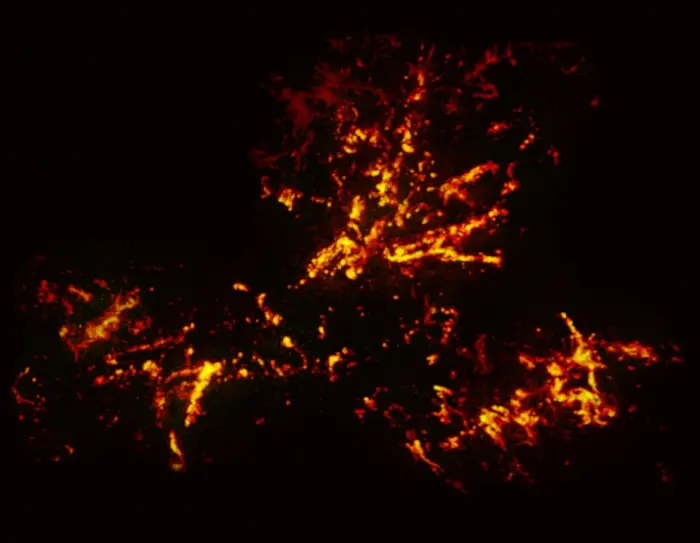
This image shows the star-forming region 30 Doradus, also known as the Tarantula Nebula, in radio wavelengths, as observed by the Atacama Large Millimeter/submillimeter Array (ALMA). The bright red-yellow streaks reveal regions of cold, dense gas which have the potential to collapse and form stars. The unique web-like structure of the gas clouds is characteristic of the Tarantula Nebula. Image credit: ALMA (ESO/NAOJ/NRAO)/Wong et al. (CC BY 4.0)
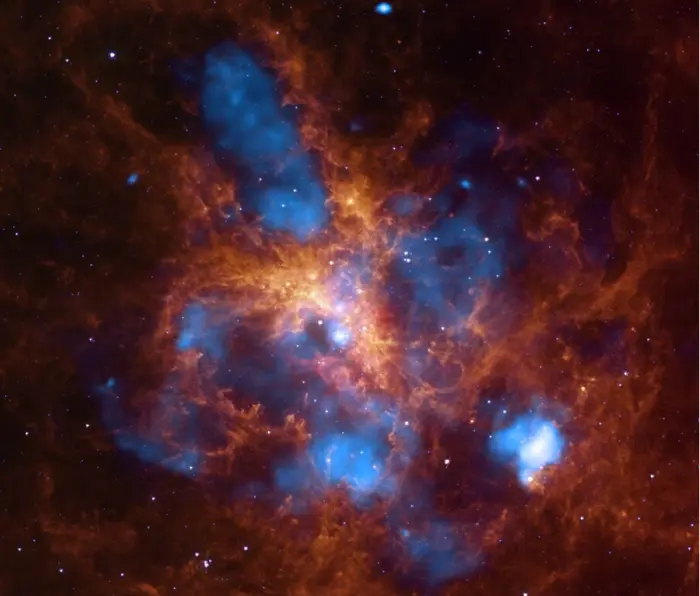
The star-forming region, 30 Doradus, is one of the largest located close to the Milky Way and is found in the neighboring galaxy Large Magellanic Cloud. About 2,400 massive stars in the center of 30 Doradus, also known as the Tarantula Nebula, are producing intense radiation and powerful winds as they blow off material.
Multimillion-degree gas detected in X-rays (blue) by the Chandra X-ray Observatory comes from shock fronts — similar to sonic booms –formed by these stellar winds and by supernova events. This hot gas carves out gigantic bubbles in the surrounding cooler gas and dust shown here in infrared emission from the Spitzer Space Telescope (orange). Image credit: X-ray: NASA/CXC/PSU/L. Townsley et al.; Infrared: NASA/JPL/PSU/L. Townsley et al.
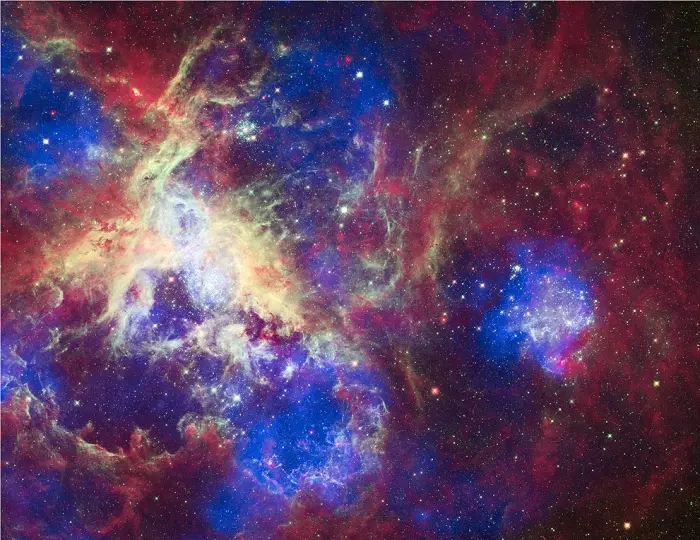
To celebrate its 22nd anniversary in orbit, the Hubble Space Telescope released a dramatic new image of the star-forming region 30 Doradus, also known as the Tarantula Nebula because its glowing filaments resemble spider legs. A new image from all three of NASA’s Great Observatories–Chandra, Hubble, and Spitzer–has also been created to mark the event. The Hubble data in the composite image, colored green, reveals the light from these massive stars along with different stages of star birth, including embryonic stars a few thousand years old still wrapped in cocoons of dark gas. Infrared emission data from Spitzer, seen in red, shows cooler gas and dust that have giant bubbles carved into them. These bubbles are sculpted by the same searing radiation and strong winds that comes from the massive stars at the center of 30 Doradus. Image credit: NASA